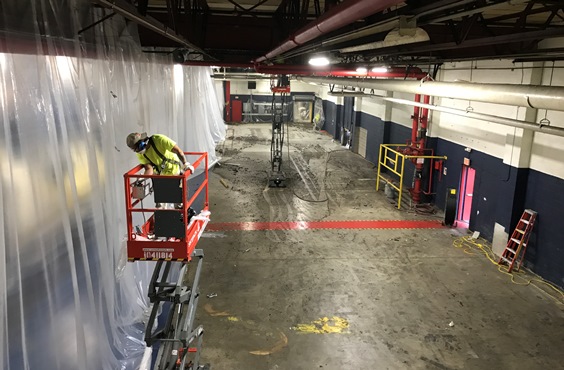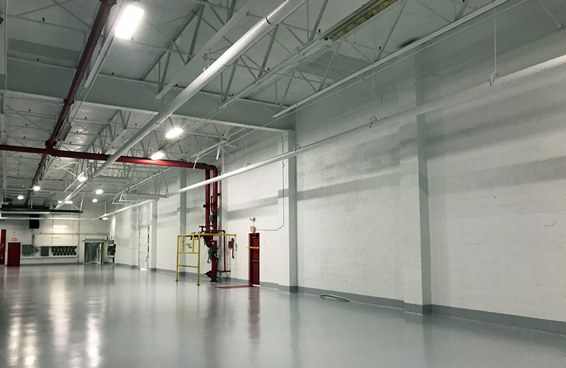Tom Cochrane’s “Life Is a Highway” has never been more right than for Jeff Neal, project manager/estimator for coating contracting firm PennCoat. He was out for a drive one day, and stopped by to see potential customers, including a manufacturing facility, which wishes to remain unnamed. It paid off.
“One of the areas that I drop by every once in a while had a project that they wanted to get done,” Neal said. The client was converting an old warehouse into a facility that needed to be Federal Drug Administration (FDA) approved. It took a five-person crew and a slew of materials, but PennCoat played its part to help that come to life.
Soakin’ It Up
The room’s footprint was 200 feet by 35 feet (61.0 m x 10.7 m), or 7,000 square feet (650.3 m²). But it was the crew’s strategy to start at the top. That meant hanging plastic panels to contain the area using 19-foot-tall (5.9 m) lifts. Not everything needed a fresh coat, after all. “We hung 1.5-mil [38.1 microns] plastic from the ceiling all the way to the floor so we could enclose the area from the side of the facility that was still operating,” Neal explained.
The crew used tape and spring-loaded clamps to hang the plastic, but it was slow going. According to Neal, it was “kind of challenging because usually the less cutting the better, the faster it’ll go, but there was conduit going in and out of the bar joists. It took a little while longer to hang the plastic than I’d estimated for.”
The work area included concrete masonry unit (CMU) block walls, steel bar joists, and acoustic panels, and all needed a facelift. The joists, in particular, were in much need of attention. “The ceiling and joints were really dirty. I don’t think they’d ever been cleaned,” Neal joked. The crew used “a high-pressure ‘air cannon’ to clean off all of the dirt and debris,” he said. The air hose was rented from Sunbelt. “After we used the high-pressure air on the ceiling, we swept up all the dirt and stretched 6-mil [152.4 microns] plastic all over the floor,” he continued. They used a thicker version on the ground “so it won’t tear when you turn [the lift]” and to contain the dust and debris once it fell from the ceiling.
Other surface prep was limited for this project. Including hanging the containment panels and sweeping the floors, the crew took about three and a half days to complete the job. The walls just needed to be wiped down, and the acoustic panels were already textured, so they had enough of a profile for the coating to grab onto. However, once the crew got to work painting the panels, they ran into another hiccup.
Apparently, panels are good for absorbing sound and paint. In fact, that was one of the crew’s biggest challenges on this project: The panels were so absorbent that they ran out of materials! “I was a little short on the job,” Neal said of the amount of material needed to coat the panels. “Luckily there’s a Sherwin-Williams down the road, so we just went there to buy more paint.”
It was also lucky for the crew that this tiny setback didn’t affect the overall timeline of the project. The client was bringing in new equipment in July, which meant they had one month to complete the recoating of all three surfaces. “It was an adequate amount of time,” Neal said. “We couldn’t take a week off or anything, but it wasn’t like we had to work weekends or a third shift to get it done.” He estimated that it added only about a day and a half.
A Tall Order
As for the material, Sherwin-Williams’ Multi Surface Acrylic Coating, the crew applied it in two coats. “We like using that Multi Surface; we thought it was a good product,” Neal said. “We wanted to use a water-based product — an acrylic instead of oil-based paint — because we didn’t want to see any yellowing.”

“What they’re trying to manufacture now is a medical-grade product, so they’re really trying to clean up the area. Coating everything with a clean, white color helps them get the FDA approval they were looking for,” Neal explained.
Using Graco spray guns, they sprayed the ceiling and bar joists to a total dry film thickness of 5 mils (127.0 microns). “Once we got to the walls, we did a combination of spraying and rolling,” Neal said. “You spray to get the material on the walls and with the roller you can move a little faster.”
They used wet film gages to confirm the thicknesses of the primer and finish coat. Other equipment they used was due to the ceiling’s heights: They relied on 75- to 100-foot (22.9‒30.5 m) hoses to reach the 23 feet (7.0 m) off the ground, and they used more clamps to attach those hoses to the lifts. That helped give the guy spraying “a little bit more flexibility to maneuver,” Neal explained.
Working at heights also required that the crew member in the lift wear safety harnesses, and all crew members on the job, whether in the air or on the ground, wore ear plugs at all times “because that equipment’s loud,” Neal said. They also used safety glasses, gloves, and masks to keep any overspray off of the skin. Most of the safety gear came from 3M on this project.
Wide Open Spaces
Aside from the extra time needed to hang the protective plastic and buy more materials for the acoustic panels, this project was fairly straight forward — 200 linear feet (61.0 m) straight, in fact. According to Neal it was “a wide open area,” and once they dropped and pitched the plastic from the walls and floors, they were left with a brand new façade. “It was night and day,” Neal said. “We had a clean section completely contrasting with a used area for the warehouse.”
Another PennCoat crew came in after this one to recoat the floors with a urethane cement system to completely renew the area, but that’s a story for another time…
